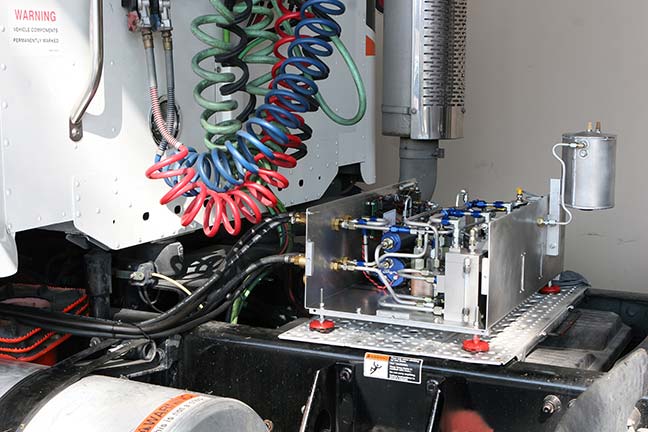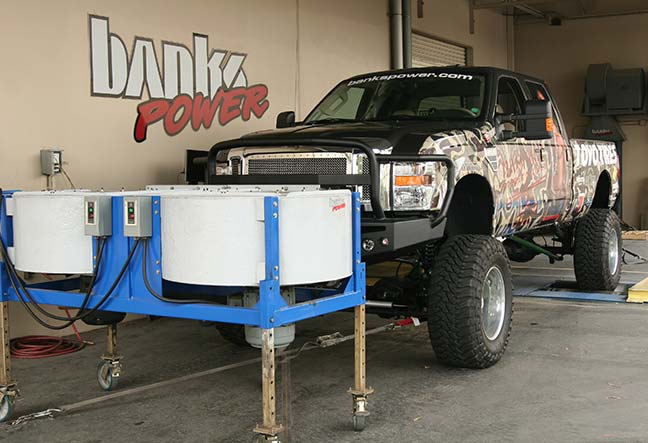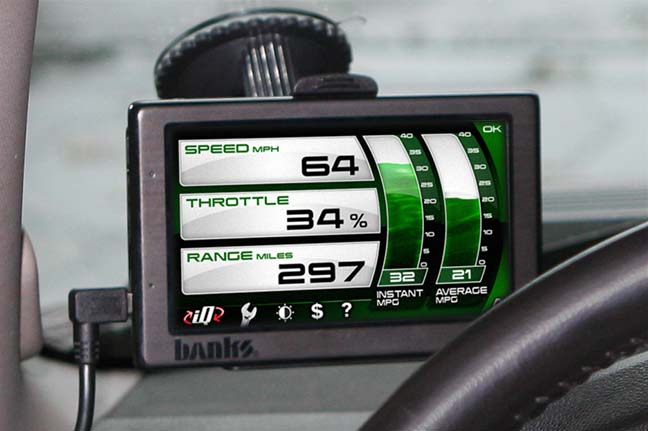The Truth About – Mileage
Fuel economy is maddeningly difficult to measure and document-even if you are the EPA. In the real world, it’s practically impossible to standardize all conditions and control all variables. But if you understand the process, you can at least develop a working strategy for maximizing your mileage.
By John Stewart
On a recent trip from Los Angeles to Phoenix, we were surprised to average 20.1 mpg in a V-8 powered pickup truck. Driving home, heading from east to west, our mileage was closer to 15 mpg, even though we drove in the cool of the night. Speeds were comparable, we even stopped at the same gas stations along the way. Puzzled, I asked a friend who made the same trip twice a month. “Oh yeah. That always happens. You get great mileage coming out, and terrible mileage going back.” What to make of it? “When you are driving west, you’re heading into the weather. It’s the wind that does it.” His theory, which may have some validity, is that prevailing weather patterns coming off the Pacific add a tailwind boost heading east, and a headwind penalty driving west. On the interstate, the resulting aerodynamic contrast results in a very apparent change in mileage.
It’s a simple observation, but it serves to underline our point. Actual real-world fuel economy varies widely, for reasons we may not notice or consider, affected by many small variables that add up.

When it comes to fuel economy, even the EPA can’t predict the actual mileage a given car will get. They can run powertrains under controlled conditions, measure fuel accurately and accumulate statistically significant data. They may have unlimited funds, vast resources and some of the best people around. It seems clear that the EPA is the best yardstick we have, but on any given day they still can’t say what your mileage will be with 100% accuracy.
Fuel economy is maddeningly difficult to measure and document, no matter who you are. To do it, you’d have to standardize all conditions and control all variables, but that’s practically impossible to do in the real world. A look at the reasons why can help us understand how to develop a working strategy for maximizing mileage.

For starters, there is an amazing number of variables at play affecting fuel economy. These include air temperature, barometric pressure and humidity–the components of air density. As density changes, performance changes and mileage changes with it. So mileage for a given vehicle can change from season to season, day to day, and hour by hour as you roll along through weather patterns, changes in altitude and changes in air temperature. Which is why the exact same trip made during different times of the year, with different weather conditions, can easily yield different mileage data.
Rolling resistance is another variable. Tire pressures are big factors there, but weight and aerodynamic drag also come into play. When tire pressures are lower, the footprint grows and the tire rolls along less easily. Over time, that burns fuel.
It’s also true that anything that makes a vehicle less aerodynamic will decrease mpg, especially at highway speeds. That includes extending towing mirrors, adding bags or a bicycle to the roof rack, or installing equipment on the roof of a motor home that might increase wind resistance. Installing taller tires and/or a lift kit would make a noticeable difference in wind resistance, especially if the new tires are of a high-traction tread design.

Actual vehicle weight is another variable. Greater weight demands more energy to accelerate, so it’s during stop-and-go, around-town driving that weight is a bigger factor. Bolting on equipment like skidplates, tow hooks or tool boxes are obvious ways to add weight quickly and adversely affect mileage. You might not be able to do much about that, but you may be able to take out the junk you have in the bed or truck that you don’t use every day. On a motorhome, weight additions can be more subtle. As your collection of tools, kitchen implements, supplies and personal items increases, your motorhome or camper gets heavier. These personal items quickly add up to hundreds of pounds, which is why RV manufacturers recommend taking your rig to a public scales periodically, to make sure you have not exceeded the GVWR. Very rarely do our vehicles get lighter as we own them.
Other variables include choice of lubricants, mechanical issues (brake adjustment, torque converter efficiency), terrain (hills etc), tuning (timing, fuel delivery characteristics, thermostat temps, etc), use of air conditioning, number of lights and traffic conditions, and top speeds. We’ve seen customers bring in their RVs complaining of poor mileage, only to find their radiators clogged with insects and their air filters filled with dust and leaves. One customer must have run through a swarm of bees, because he had hundreds in his intake.
When it comes to lubricants, it’s generally agreed that synthetic oils can improve mileage because they offer the same protection with less viscosity, which is why OEMs are using them more and more. But even moving from a summer to a winter oil, synthetic or not, can make a difference. Air conditioning is also cited as a well-documented mileage-killer, somewhere in the range of 4-6% on the average car. That said, it’s also been shown that for highway driving, you’re better off running the A/C than driving with the windows down, which upsets your car’s aerodynamic profile.
Cruising speed is another significant factor. It’s estimated that cruising at 75mph is 25% less efficient than cruising at 55 mph, a statistic that emphasizes how quickly fuel demands climb as speeds increase.

While these and other variables certainly do add up, the biggest variable by far is the nut behind the wheel. That’s right-the driver. Driving style has an enormous impact on fuel consumption, and when driving style varies, mileage varies. So the guy who has a fight with his wife before he leaves the house in the morning probably gets worse mileage than he did the day before, when he was calm and relaxed. A week later, when he fills up and logs the mileage, he wonders why this particular tank full was below par. It’s also common to find that drivers react positively to performance upgrades, in the sense that they tend to enjoy the newly-available benefits by driving differently. Instead of getting better mileage by operating at part-throttle more often, they get worse mileage by going faster. A third phenomenon, known as “speed creep,” is the tendency for drivers to gradually increase average speeds the longer they stay on the road.
Given these realities, what is a practical, real-world strategy to get the best mileage your vehicle can deliver? And when you install mileage-improving equipment, how do you know it really works?
Let’s address the driving strategy question first. Your most important priority would be to adopt a consistently controlled driving style. That means avoiding full-throttle starts, accelerating up hills and driving at higher speeds. Instead, use cruise control as much as possible, and cruise at rational speeds. Accelerate only as rapidly as necessary, and begin your braking with a long, no-throttle coast-down before you touch the brakes. If mileage really is your priority, you’ll need to resist the temptation to power up hills like never before.
Professional drivers also save fuel by planning their trips, often using GPS to ensure that they don’t get lost and wander off course as they travel through unfamiliar areas. It’s a small thing to keep your tire pressures at or close to the maximum, and to keep your air filter clean enough to maintain optimum air flow. Realistically, you’ll use A/C when you have to, but you have the option to consider the cost as you go.

The next question is harder to answer: How can you track mileage yourself, and be reasonably confident of the results? With so many variables in play, it’s not easy. If you keep your own log, tracking gallons in and miles covered, you’ll realize quickly that the mileage readout on your dash is almost always wrong, sometimes by quite a bit. To get it right, you’ll need to do three things with a high degree of accuracy:
Measure the distance traveled. Sounds easy, but in fact the odometer is not a tremendously accurate or consistent indicator of actual distance traveled. From vehicle to vehicle, odo readings may vary as much as 10 percent, depending on axle gearing and tire size. Change your tire diameter, and the odo will start fibbing. Change tire size a lot, and it will lie like a dog. Better to use GPS-based tools to improve the accuracy of your mileage measurement.
Measure the fuel used. The accuracy of measuring the amount of fuel used is critical to the end result, and is probably the hardest data set to obtain accurately. One method would be to fill the fuel tank as completely as possible at a filling station pump, run the test and then fill the tank to the same level and take the reading from the filling station pump (commonly shown to three decimals, or one one-thousandth of a gallon). The problem with this method is that the fuel in the tank cannot be seen, and it is possible to have air pockets in the tank that haven’t been filled. Another method is to weigh the amount of fuel before and after a test, but this requires a remote tank. A third method is the use of a fuel flow meter. This requires insertion into the existing fuel lines, but offers the most accurate method for measurement of fuel used. At GBE, we use a fuel flow meter that is accurate to .00003 gallons (3 one hundred-thousandths of a gallon). This is roughly 33 times more accurate than the typical fuel pump.
Accumulate significant mileage: It is desirable for conditions to be as repeatable as possible when making MPG comparisons between two different configurations, but in the real world, there will always be variables. Some of these can be averaged out by logging data over many tankfulls. In our testing here at Banks, mileage may be accumulated on the road or on a chassis dyno.
On the road, variables include traffic and weather conditions (weather conditions also may impact traction, rolling resistance and aerodynamics). It is also relatively difficult to ensure that the driver will repeat his driving style consistently on the open road. The use of a chassis dyno will minimize most of these variables. Because the vehicle is stationary, traffic and weather related issues are eliminated. In addition, the use of predefined drive traces will ensure minimal variation from the driver.
In the old days, we would perform fuel economy tests by filling a vehicle as full as we could, use a consistent driver to run a test loop that was a little more than 100 miles while trying to maintain repeatable driving conditions and monitoring weather conditions, and then repeat the process after a product was installed. If we encountered heavy traffic or adverse weather, we would repeat the tests until we felt that we had accurate data. Road testing accuracy was improved moderately by using GPS distance measurement and a fuel flow meter.
More recently we have equipped the vehicle with the fuel flow meter and used drive cycles on the chassis dyno. This can be done using the FTP (Federal Test Procedure) protocol which replicates an urban drive condition and an EPA highway trace. These are the same drive traces that are used to publish the government required City and Highway fuel economy numbers shown on the window sticker of new cars. As we said, the EPA test might not be perfect, but we think it’s still the best available. When we use this method, we repeat each drive trace a minimum of 3 times and sometimes as many as 5 or 6 to ensure repeatability in the data. We can also set the dyno to simulate different weight conditions, which allows us to offer both solo and towing fuel economy results. This method yields an extremely accurate measurement of fuel economy, down to fractions of one mpg. Even so, we continue to do real-world testing, because the dyno method is somewhat sterile. We often find that customers will report different (often better) results in the real world, especially if they don’t drive too aggressively. We’ll continue to report the mileage data we see from our tests when we introduce our new products, but it’s important for customers to have realistic expectations. Just like the EPA says, your mileage will depend on how you drive…and a bunch of other things.
Because mileage testing is likely to be important to our customers, we’ve added enhanced mileage-logging capabilities to our dashboard PC, the Banks iQ. The iQ combines GPS-based mileage tracking with monitoring of your fuel supply, so it’s more accurate than the OEM display on your dash. It’s set up to slice fuel consumption data any way you want it, to provide trip average, mileage you’re getting at any given moment, miles-to-empty and other useful statistics. There is also a log book you can use to review your trips over the long haul, so you can store and compare mileage between various trips and routes. You may find some routes are more efficient than others. In short, the more consistent you can be, and the more you reduce the effect of mechanical and human factors, the better you will be able to see what is really happening in terms of fuel consumption.

